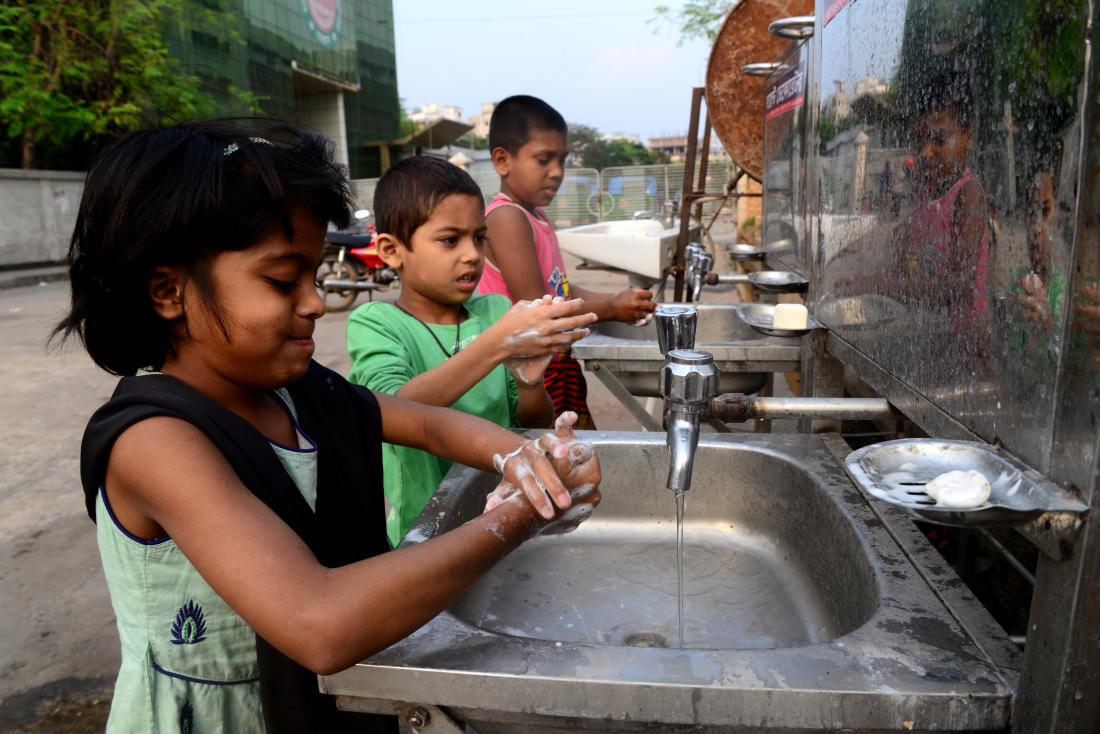Changing Handwashing Behavior with Edutainment in Bangladesh
- Families and households
- Diarrhea
- Health outcomes
- Take-up of program/social service/healthy behavior
- Information
- Edutainment
Every year, nearly one million people die from diarrheal and respiratory illnesses due to unsafe sanitation and hygiene practices. Researchers conducted an evaluation to test the impact of a hand-hygiene edutainment (entertainment education) campaign on handwashing and health in Bangladesh. The campaign improved handwashing and child health but had no impact on hygiene knowledge.
الموضوع الأساسي
Every year, unsafe sanitation and hygiene practices cause nearly one million deaths from preventable diarrheal and respiratory illnesses and stunt the growth of millions of children. Improving individual hygiene behaviors like handwashing with soap can prevent illness and be a less costly alternative to infrastructural investments.
Public health information campaigns can transfer knowledge and therefore potentially shift behaviors, but many do not successfully change behavior. Could embedding hand-hygiene information within popular dramas improve hygiene knowledge and behaviors as well as child health in Bangladesh?
سياق التقييم
In Bangladesh, where this study took place, diarrheal disease caused 37, 358 deaths and respiratory infections caused another 68,443 deaths in 2017.12 Among the study participants in Bangladesh’s Gaibandha District, 100 percent of households owned soap and 99 percent washed their hands with water before they eat. However, the population’s hand hygiene knowledge was lower—while 83 percent of mothers trusted that soap kills germs, 64 percent thought that if their hands looked clean then soap would not provide additional hygiene. Additionally, 54 percent of mothers knew handwashing could prevent diarrhea, but only 2 percent believed it could prevent colds.
Mobile phones are one platform through which entertainment education or edutainment can be delivered. In Bangladesh, mobile phone usage in rural areas has quickly increased—mobile subscriber penetration rose from 1 percent in 2003 to 51 percent in 2017—making disseminating an edutainment campaign easier.3 However, media streaming remains challenging due to unreliable network capability and internet accessibility so many individuals utilize preloaded SD cards to view entertainment.

معلومات تفصيلية عن التدخل
Researchers conducted a randomized evaluation to test the impact of a hand-hygiene edutainment campaign on handwashing knowledge and behavior as well as child health in Bangladesh.
Researchers randomized 333 households across 34 villages in Gaibandha District into two groups via a computer:
- Edutainment Campaign (167 households): Households received a hand soap dispenser and a mobile phone with a preloaded edutainment campaign that depicted why, when, and how to properly wash their hands.
- Comparison group (166 households): Households received a hand soap dispenser but were not exposed to the edutainment campaign.
The intervention lasted eight months from April to November 2017 with a follow-up survey in April 2018. Researchers collected data on media engagement, handwashing behavior, knowledge of hand hygiene, and child health. The researchers measured handwashing behavior using time-stamped sensors attached to the hand soap dispensers given to each household.
النتائج والدروس المستفادة بشأن السياسات
The hand-hygiene edutainment campaign improved household handwashing practices and child health, but had no impact on hygiene knowledge.
Edutainment exposure: Mothers who received the edutainment campaign reported using a mobile device for entertainment 73 percentage points more than mothers in the comparison group (a 340 percent increase). Children in the intervention group were 38 percentage points more likely to use a phone as a source of entertainment than those in the comparison group (a 132 percent increase).
Hand hygiene behavior and knowledge: The edutainment campaign had no impact on the likelihood of any use of the soap dispenser, but intervention households did use the dispenser 22 percent more per day than participants in the comparison group. However, the impact on daily handwashing was not driven by a change in knowledge, signaling the edutainment campaign had no impact on household’s explicit knowledge and beliefs about handwashing.
Child health: The edutainment campaign improved child health, leading to a 0.007 percentage point reduction in the incidence of loose stool (a proxy for diarrhea) from a base of 1 percent (a 54.4 percent decrease) and a 0.023 percentage point reduction in acute respiratory infection symptoms from a base of 7 percent (a 28.8 percent decrease) among children aged twelve and below.
Saloni, Dattani, Fiona Spooner, Hannah Ritchie, and Max Roser. 2023. “Diarrheal Diseases.” https://ourworldindata.org/diarrheal-diseases.
